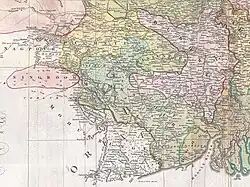| Manbhum | |
|---|---|
| 1833–1947 | |
 District map of Bengal administration | |
| Capital | • Manbazar • Purulia[1] |
| Area | |
• 1833 | 20,449 km2 (7,895 sq mi) |
• 1901 | 856,458 km2 (330,680 sq mi) |
| Population | |
• 1901 | 1,301,364 |
• 1931 | 1,810,890 |
| History | |
• Formation | 1833 |
| 1947 | |
• Bifurcation | 1956 |
| Today part of | West Bengal: Purulia |
Manbhum District was one of the districts of the East India during the British Raj.[2] After India's independence, the district became a part of Bihar State. Upon the reorganization of the Indian states in the mid-1950s, the Manbhum district was partitioned based on language. The Bengal-speaking areas were included in West Bengal, while the rest were kept with Bihar (present-day Jharkhand).
Etymology
Manbhum gets its name from the 16th century military general Man Singh I who is known for his conquests Of Bihar, Odisha and parts of Bengal. He later also served as the governor (Subahdar) of this region during the reign of King Akbar.[3]
In other versions, the district name derived from Manbazar or Manbhum khas parganas. The headquarters of Jangal mahal region from around 1833 to 1838, when the district was formed.[4]
History

In 1833, the East India Company formed the Manbhum district with its headquarters in Manbazar, covering an area of 7,896 square miles, by dividing the Jungle-Mahal region to enhance administrative efficiency. In 1838, the headquarters shifted to Purulia, and over the following years, the district underwent several divisions. These divisions occurred in 1845, 1846, 1871, and finally, in 1879, reducing its size to 4,112 square miles. In 1912, Manbhum became a part of the Bihar and Orissa Province.

On 1 April 1936, the Bihar and Orissa Province was partitioned into two separate provinces Bihar and Orissa based on language, though Manbhum continued to remain a part of Bihar. Post-independence, linguistic tensions emerged in the district due to imposition of Hindi language over the native Bengali-speaking majority. This led to the establishment of the "State Reorganization Commission" on December 23, 1953. The commission recommended the creation of a new district named "Purulia," primarily for Bengali speakers, by carving it out of the former Manbhum district in Bihar. The proposed Purulia district included 19 police stations from Manbhum, while 10 police stations from the Dhanbad sub-division and 2 police stations from the Purulia sub-division of Manbhum remained in Bihar.
Subsequently, three police stations of West Bengal —Patamda, Ichagarh, and Chandil—were transferred to Bihar upon a special request from TISCO, Jamshedpur. The "Bengal-Bihar Border Demarcation" Bill was passed in Parliament on August 17, 1956, and in Rajya Sabha on August 28, 1956, ultimately receiving the signature of the President of India on September 1, 1956. Consequently, on November 1, 1956, Purulia officially became a part of West Bengal, comprising 16 police stations, covering an area of 2,007 square miles, and hosting a population of 1,169,097. However, other areas, including Patamda, Ichagarh, and Chandil, continued to remain under the jurisdiction of Bihar. Furthermore, on November 15, 2000, South Bihar was bifurcated to form a separate state called Jharkhand due to demographic disparities between North Bihar and South Bihar. Today, these areas form parts of the Dhanbad, Bokaro, Ranchi, Saraikela Kharsawan and East Singhbhum districts in Jharkhand.
Demographics
Language of Manbhum
As of the 1931 census, the Manbhum district recorded a total population of 1,810,890, with 940,009 males and 870,881 females. In terms of linguistic diversity, Bengali constituted the majority with 1,222,689 individuals, followed by Hindi speakers at 321,690 and the Santal community at 242,091. Other noteworthy linguistic groups encompassed Koda (4,623), Bhumij (2,918), Gujarati (1,912), Kharia (1,995), Marwadi (1,774), Odia (1,563), Karmali (1,568), Telegu (1,332), Kurukh (946), Naipal (662), Punjabi (661), Mundari (789), Tamil (525), Mahali (312), and Ho (57).[5]
In terms of social demographics, the Kuṛmi comprises the largest percentage at 17.84%, followed by Santal at 15.59%. Other significant caste groups include Bauri (6.7%), Bhumij (5.74%), Brahman (4.58%), Kumhar (3.15%), Jolha (3.12%), Teli (2.68%), Goala, Ahir and Yadav (2.26%), Rajwar (2.15%), Kamar (1.95%), Bhuiya (1.86%), Rajput (1.7%), Hajam/Nai(1.38%), Dom (1.36%), Hari (1.15%), Ghatwar (0.98%), Mochi (0.94%), Kora (0.86%), Kayastha (0.8%), Dhobi (0.79%), Kahar (0.78%), Tanti (0.65%), Mahli (0.6%), Bania (0.56%), Koiri (0.54%), Chamar (0.51%), and Kewat (0.5%).[5]
See also
References
- ↑ The Calcutta Review. 1869. p. 116.
- ↑ Chisholm, Hugh, ed. (1911). . Encyclopædia Britannica. Vol. 17 (11th ed.). Cambridge University Press. p. 542.
- ↑ Roy, B. C. (1950). "Raja Mansingh and the Final Conquest of Orissa by the Mughals". Proceedings of the Indian History Congress. 13: 243–253. ISSN 2249-1937. JSTOR 44140922.
- ↑ Coupland 1911, p. 1–2.
- 1 2 Lacey, W. G. (1932). Census Of India 1931 – Bihar and Orissa. Vol. VII. Part II, Tables. p. 138.
Source
- Coupland, H. (1911). Bengal District Gazetteers Manbhum. The Bengal Secretariat Book Depot Calcutta. Archived from the original on 29 May 2022. Alt URL
- Bhattacharya, Birendra ku. (1985). Bengal District Gazetteers (Purulia) (PDF). Narendra Nath Sen, State editor, West Bengal district gazetteers. Archived (PDF) from the original on 15 November 2016.
23°20′N 86°22′E / 23.333°N 86.367°E